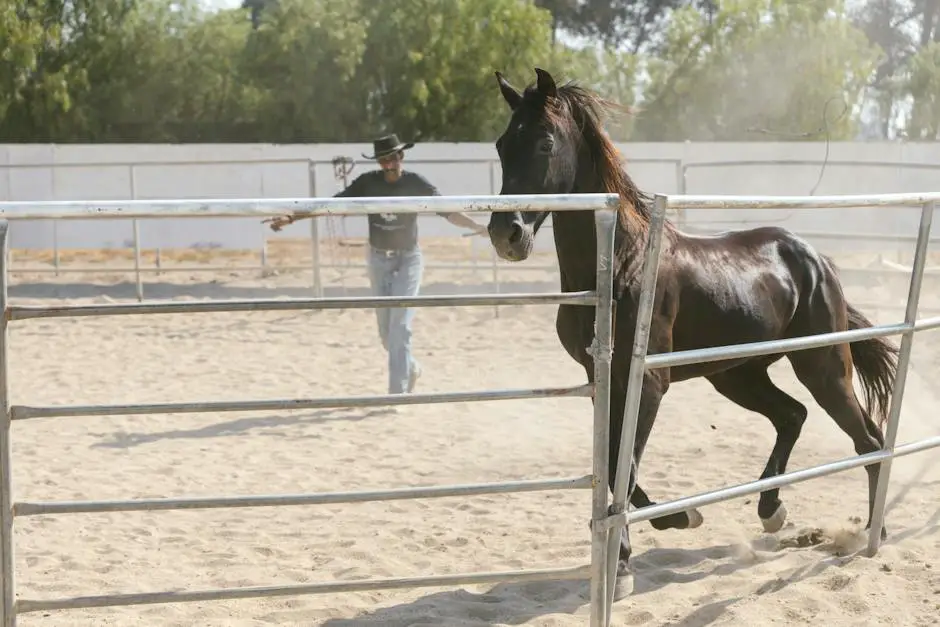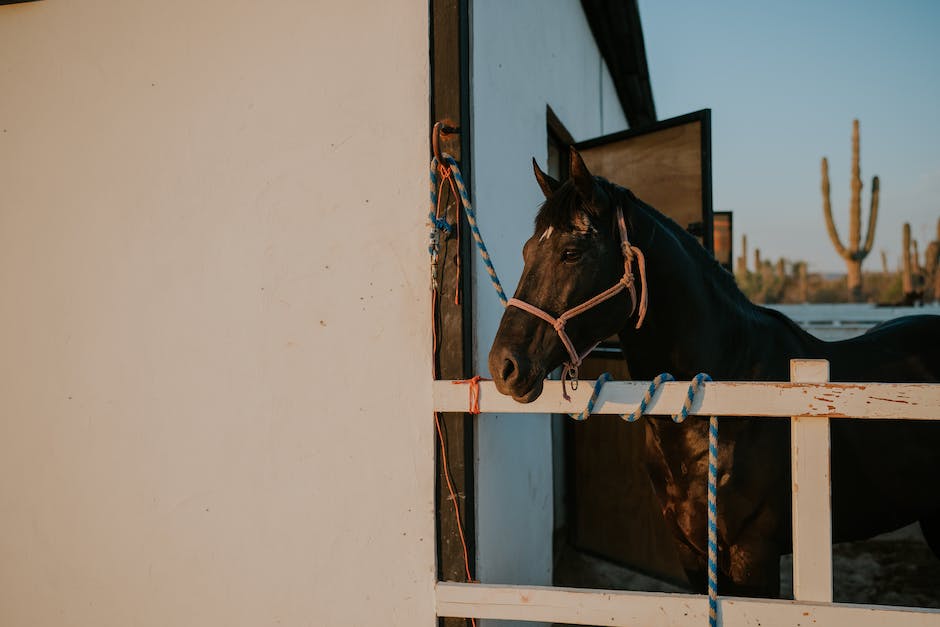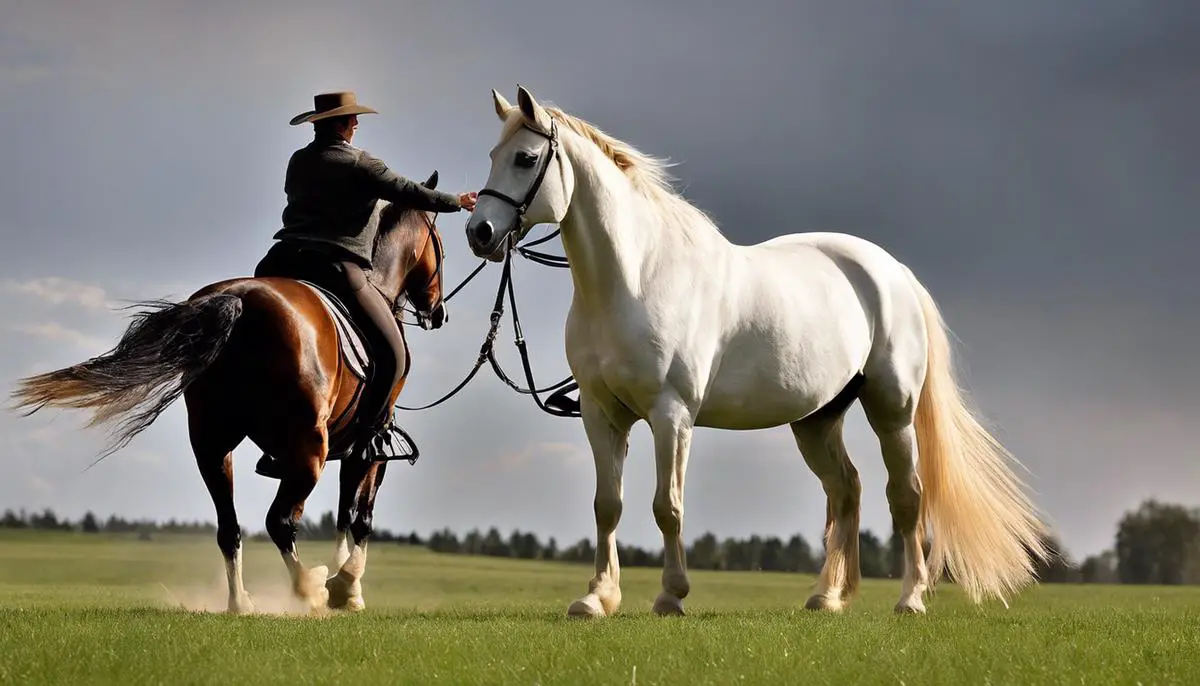Swiss horse training, with its deep-rooted traditions and innovative methods, has etched its remarkable presence in the global equestrian scene. Rooted in a rich history, this unique training ethos gives due respect to the nobility of the animal, converted into a teaching method that emphasizes on natural horsemanship and two-way communication with horses. This journey into the realm of Swiss horse training begins with an overview of its fundamental principles and distinct aspects. From there, readers will be guided through the indispensables – the tools and the equipment that ensure the tranquility and efficiency of the process, and onto a detailed elucidation of the step-by-step process of taking a young horse from novice to an advanced level of training. Ending the journey will reveal the common challenges faced in Swiss horse training along with the solutions, and a display of real-life success stories that breathe life into the learnt concepts.
Table of Contents (Horspedia)
Overview of Swiss Horse Training Techniques
Unraveling the Art of Swiss Horse Training: A Unique and Effective Approach
Whether you’re a thoroughbred veteran or a greenhorn inexperienced in the equestrian world, the Swiss horse training techniques are bound to intrigue you. These techniques stem from centuries of Swiss horse-rearing culture that bank on logic, gentleness, and intricate understanding between the horse and the handler. It’s a holistic approach that not only prioritizes the sporting competence of the horse but also their physical and psychological well-being.
Let’s delve into this alpine secret that’s fascinating the global horsey world.
Core to Swiss horse training techniques is the belief that every horse is unique with its own set of strengths and weaknesses. This acknowledgement gives way to a highly customized training approach that fits each horse accordingly. The Swiss are known for their attention to detail, and this quality shines in the way they patiently study each horse’s quirks and demeanor before outlining a training regime. It’s never about fitting the horse into a pre-established plan; rather, the plan evolves to meet the horse’s needs.
Placing emphasis on trust and respect, Swiss trainers establish a strong bond with their horses, viewing them as partners rather than mere sporting tools. The focus is always on gaining the horse’s confidence rather than dominating them. This trust-building phase often involves plenty of groundwork exercises and desensitization training that aids in tempering the horse’s fear reflex and nurturing a calm, composed demeanor.
Interestingly, Swiss techniques encourage little to no use of artificial aids such as bits and spurs. The Swiss put forth the idea that natural aids – the rider’s body language, voice, legs, and hands – when used judiciously and correctly, can be potent resistance-free communication systems. This involves teaching the horse to understand subtle cues, effectively building a communication channel that’s both gentle and effective.
Consistency and patience are pillars of Swiss horse training techniques. There’s no rush to get the horse in the competition ring. The Swiss believe in taking the time to build a strong foundation, even if it means progressing at a seemingly slower pace. Let’s not forget, they also focus on the handler’s education. They offer insights into equine behavior, teaching handlers how to read their horses, discern signs of discomfort, stress, or misunderstanding, and how to appropriately respond to these signs.
Swiss training techniques also encompass the horse’s overall lifestyle. From the horse’s diet, physical health, to pasture time, every element is monitored carefully to ensure the horse is growing in the best possible environment. Swiss trainers are a firm believer that nurturing a healthy, happy horse is paramount to success in any arena.
While this Swiss methodology might seem unorthodox, or slow-paced to some, its innate ability to create mentally sound, physically fit, and cooperative horses is irrefutable proof of its effectiveness. This holistic, compassionate approach is surely a noteworthy contribution to the echelons of world horse training methodologies, intriguing equestrian enthusiasts every trot of the way.

Tools and Equipment for Swiss Horse Training
Essential Tools and Equipment for Swiss Horse Training
Swiss horse training places less emphasis on artificial aids, focusing instead on building a sense of trust and respect between horse and trainer. However, it does help to have a few key pieces of equipment on hand to facilitate the process both for the trainer and the animal. Knowledge is indeed power, especially when it gets translated into practical skills. Here are some fundamental tools for Swiss horse training that all hobbyists should know about.
- Safety Gear: First and foremost, engaging in Swiss horse training requires appropriate safety gear. This includes sturdy boots, helmets, gloves and possibly a safety vest. While these items do not directly affect training, they do ensure the security of the handler, which in effect, contributes to the welfare of the animal.
- Training Halter: A high-quality training halter is essential, specially one that fits the horse correctly. An ill-fitting halter can cause discomfort and even injury to the horse, impeding training progress. A properly fitted halter aids in clear communication with the horse during the training sessions.
- Lead Ropes: Lead ropes are another fundamental tool in the Swiss horse training toolkit. These are used to guide the horse during training sessions. Select lead ropes that are durable, easy to handle, and have a solid clasp to ensure they stay securely attached to the halter.
- A Lunge Line and Whips: For groundwork exercises and to refine a horse’s behavior and responses, a lunge line and whips are often used. Remember, Swiss-trained horses are trained with minimal use of artificial aids, so these equipment should be used judiciously and only to define spatial boundaries, not as a punishment.
- Brushes and Grooming Kits: While these may not immediately come to mind when you think of Swiss horse training, regular grooming fosters trust and respect between the horse and handler. Having a comprehensive grooming kit including curry combs, body brushes, a mane and tail comb, and hoof picks is vital.
- Exercise Equipment: This includes horse exercise balls and cones which can be used to set up obstacle courses or to teach a horse certain movements.
- Horse Saddles and Bridles: These can be used once the horse has developed a certain level of trust and is receptive to being ridden. There’s a wide range available so ensure to consider the horse’s size, breed and comfort before selecting.
- Treat-Dispensing Toys: A less common but effective tool used in Swiss horse training. These toys are a great way to reward your horse during and after training sessions, promoting a positive training environment.
Every horse is unique and reflects knowledge and consistency differently. Understanding the personality and requirements of the horse, along with having these essential tools at one’s disposal, can undoubtedly make the Swiss horse training process smoother and more effective. After all, the goal is not just a well-trained horse, but a mentally sound and cooperative companion. So, equip yourself with the right tools and you’ll be well on your way to successful Swiss horse training.

Step-by-Step Swiss Horse Training Process
The Swiss horse training process is a meticulously designed series of exercises, engagements, and interactions that invigorate the physical and mental fitness of the horse while fostering an enduring connection with the handler. Using time-honored techniques that represent the essence of Swiss horse training, the steps involved reflect a commitment to fostering a genuine rapport with the horse.
Fundamental to Swiss horse training procedures is the seamless integration of safety gear into the training regimen. A well-fitted training halter is paramount. It is crucial not only for the handler’s control, but also potentially serves to avoid discomfort or injury to the horse.
Guiding the horse follows, utilizing lead ropes. An essential tool, lead ropes help to dictate direction during the training session subtly, assertively guiding the horse without prompting undue stress or anxiety. Here, the focus lies on subtly and tact, refraining from brute force or aggressive tactics that may counteract trust-building efforts.
Groundwork exercises are the next milestone, employing lunge lines and whips for these exercises. These tools, when used adeptly, allow trainers to refine and shape particular behaviors in the horse without resorting to physical contact that could be viewed as coercive or punishing. This approach acts as an extension of the philosophy of respect and trust in Swiss horse training practices.
Routine grooming is another vital step, demanding a comprehensive grooming kit. Regular grooming not only contributes toward the horse’s physical well-being but also operates as a powerful bonding exercise between horse and handler.
Incorporating exercises using specialized equipment like exercise balls and cones is also key in the training process, aiding in the setting up of obstacle courses. These provide an engaging, stimulating environment for the horse, contributing to the overall physical dexterity and mental agility.
Once the horse has gained adequate skills during groundwork and obstacle navigation, it’s time to introduce saddles and bridles. Selecting the appropriate saddle and bridle takes skill and understanding as these are crucial components that assure comfort and safety when the horse is ready for riding.
Lastly, the use of treat-dispensing toys features in Swiss horse training, operating as a form of positive reinforcement. Not only do these toys offer a fun element to the training, but they also reward the horse for good behavior and foster motivation for learning new skills.
To sum up, the Swiss horse training process is an amalgamation of traditional techniques and progressive practices, revolving around the golden principles of patience, consistency, respect and understanding of equine behavior. With safety gear, guided exercises, regular grooming, varied physical activities, the introduction of riding equipment and positive reinforcement, this process is wonderfully effective. It is one that carefully nurtures and encourages the horse’s mental, emotional, and physical growth, creating a balanced and cooperative horse ready to interact in complete harmony with humans.

Common Challenges and Solutions in Swiss Horse Training
In Swiss horse training, stakeholders may confront a set of common challenges that can make the journey less than smooth. Understanding these hurdles and the optimum ways to address them, can indeed transform the venture into a pleasant and rewarding experience for all involved.
One of the primary challenges faced during Swiss horse training is communication. Since horses are non-verbal creatures, understanding their unique body language can be a tough nut to crack. Misreading or misunderstanding their cues can lead to inappropriate responses, breaking a trust bridge built with effort and time. To mitigate this, keen observation, and knowledge about equine behavior plays a key role. Hands-on programs, workshops, online resources, or guidance from seasoned trainers can provide essential know-how in reading and responding to horse’s signals effectively.
Further down the line, another challenge presents itself when the trainer encounters a horse with prior adverse experiences, which might have led to the development of fear or anxiety. In such cases, the usual trust-building methods may turn out to be ineffective or drastically slow. Here, slow, patient, and compassionate handling goes a long way. Employing gradual, positive, exposure therapy under a trained vet’s guidance can also help.
Another issue springs up when dealing with physically unfit horses. This could be due to lack of exercise, age, past injuries, or health conditions. The Swiss methodology’s focus on the horse’s overall lifestyle and well-being comes to aid here. Proper diet, regular exercise, and health check-ups can ensure the horse’s physical fitness, ruling out any hindrances in the training process.
Mismanagement of equipment is another challenge, primarily when the handler is not well-versed with its appropriate usage. Using lead ropes, lunging lines, or treat-dispensing toys in an incorrect way not only fails in serving their intended purpose but also can pose a threat to the safety of both the horse and the handler. Acquiring hands-on training on how to efficiently use these tools can prove beneficial in this regard.
Finally, difficulties can arise if there is inconsistent or undirected training. Training without specified goals or inconsistent sessions can create confusion for the horse, making it difficult for both the trainer and the equine to make any measurable progress. Consistent training schedule, incremental goal-setting, and regular progress assessments can streamline the training process, paving the way towards a well-trained, mentally sound, and cooperative horse.
By addressing these challenges appropriately, Swiss horse training can effectively produce cooperative, well-adjusted equines, ready to take on the challenges of the equestrian world. While the journey may seem imbued with difficulties, remember, every hurdle crossed is not only a victory for the horse but a testament to the trainer’s prowess and understanding.

Success Stories of Swiss Horse Training
Let’s unfold some success stories that paint a picture of the triumphs of Swiss horse training. These are tales of defining moments, crowning achievements, and hard-won victories, each one bearing testament to the efficacy of the Swiss horse training method.
An instance that instantly comes to mind is the magnificent “Lady of Rohan” tale. A mare with a reputation of belligerence and a notorious aversion to human presence emerged as one of the most cooperative and performance-ready horses after successfully undergoing Swiss training. Lady’s incredible transformation was a shining testament to the effectiveness of patient handling, clear communication, and an understanding of equine behavior.
Another remarkable Swiss horse training success story revolves around “Storm Dancer,” a Thoroughbred with a rich racing history but a challenging temperament. Under the nuanced guidance of a Swiss trainer employing the specific handling techniques and holistic approach central to the method, Storm Dancer went from an aggressive and difficult-to-handle horse to a calm, approachable, and responsive therapy horse providing emotional support to individuals.
The saga of “Mountain Echo,” an underweight and skittish horse rescued from abandonment, is as heartwarming as it is inspiring. Thanks to the Swiss training regimen’s emphasis on overall well-being and lifestyle, Mountain Echo’s transformation was not only psychological but physical. A consistent diet and exercise program, coupled with patient and respectful training, allowed Echo to blossom into a healthy, confident companion horse.
The story of “Silent Legend,” a stallion known for his unwillingness to accept saddles and bridles, adds further credence to the success of Swiss horse training. Through gradual exposure and the careful introduction of riding gear, Silent Legend transitioned towards accepting saddles and bridles, demonstrating the effectiveness of Swiss horse training in even the most challenging situations.
Yet another success story is “Wild Spirit,” whose fear of obstacle courses was well-known. Through Swiss training that incorporated clever usage of exercise equipment like balls and cones, Wild Spirit progressively overcame his fears and became known for his agility and nimbleness on even the most complex obstacle courses.
Each story of transformation resonates with the principles of Swiss Horse Training— patience, consistency, respect, understanding, trust, communication, diet, exercise, and understanding horse behavior. These are not just tales of horses moving from aggression or fear to cooperation and trust, but stories of trainers reaffirming their faith in this effective and humane training methodology.
These success stories also underscore the premise that the Swiss approach isn’t just about training horses—it’s about transforming lives, both equine and human alike. But remember, like all good things, mastery takes time. Remember to enjoy the journey!

The success stories demonstrated in this discourse underline the potency of the Swiss horse training techniques. They are real-world testaments to how diligent application of these heritage-steeped methods can turn amateur equestrians into accomplished trainers and young horses into skilled companions. By negotiating the common challenges and leaning on the provided solutions, anyone with a genuine interest and passion can explore the extensive possibilities of this discipline. The world of Swiss horse training is as infinitely rewarding as it is complex – an enriching endeavor for those daring enough to delve into it. The principles, methods, and success stories shared here serve not just as a guide but also an inspiration for courageous dreamers and budding horse trainers. The Swiss method isn’t just about horsemanship – it’s about a deeper dialogue, unwavering respect, and a lasting bond between human and horse.

